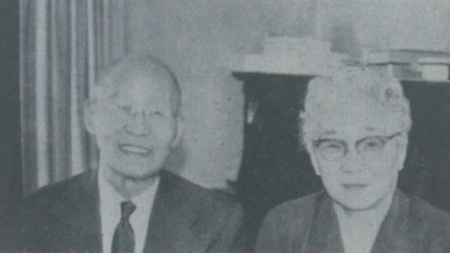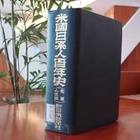In "Centennial History," Chapter 19 introduces the footprints and activities of Japanese and Japanese-Americans in the four states surrounding the Great Lakes: Ohio, Indiana, Michigan, and Wisconsin. In this book, it is written as Ohio and Michigan, but here it is Ohio and Michigan.
The four states together take up about 10 pages, which is quite a small amount, with Ohio taking up six of those pages.
In Ohio, there are a few Japanese people living in Cleveland, followed by Cincinnati. Most of them work in companies or factories, and agriculture is almost nonexistent.
The Japanese population gradually increased from 27 people in 1900, decreasing once in 1940 just before the start of the war, but rapidly increased after the war, reaching over 3,300 by 1960.
The earliest known Japanese people in Cleveland were those who sold Japanese items at the St. Louis World's Fair in 1904. Among them was a man named Ito who sold tea and later ran art exhibitions.
Others, such as Eijiro Tange (from Aichi Prefecture), started selling Japanese tea around 1910, married a white woman and became successful in business. He bought land in an upscale residential area and created a Japanese garden, but failed when he tried to run a Western-style restaurant and moved on to other businesses.
Japanese tea became very popular and several tea businesses appeared. Around 1926, Japanese people organized mutual aid societies, purchased cemeteries, and built graves.
Promoting the relocation of Japanese people
When the war began, a local office of the War Relocation Administration was established in Cleveland, promoting the relocation of Japanese Americans to Cleveland and neighboring states. It looked after people relocating from California and other places. The Cleveland Christian Union was responsible for arranging the relocation, and organized the "City Japanese Relocation Committee," which helped residents better understand Japanese Americans by arranging housing and job opportunities.
The Relocation Bureau also set up a "Japanese Speaking Group" during the war for the relocated Issei. Through these efforts, the relocated people eventually settled down and found a variety of jobs, including as art dealers, laundries, bicycle repairmen, and Western-style restaurants.
Author of "The Samurai's Daughter"
Cincinnati, with its large German population and favorable attitudes toward Japan, is also where one Japanese woman became a bestselling author in America. Etsuko, the daughter of the Inagaki family, a samurai of the Nagaoka domain, came to America in 1898 at the age of 26 and married Sugimoto, who was already an antique dealer there. The couple was loved by the Wilson family, a prominent local family, and through this connection they were able to make connections with an American publisher, and Etsuko's book, "A Daughter of the Samurai," was published.
This became a bestseller, was translated into seven languages, and spread worldwide. After her husband passed away, Etsuko returned to Japan, but returned to the United States and became a lecturer on Japanese culture at Columbia University.
There were also Japanese known as potters in Cincinnati, such as the elderly Shiroyamatani from Hagi, Yamaguchi Prefecture, who was employed for many years by the Rookwood Pottery Company, famous for producing fine art pottery. In the academic world, there was Tashiro Shiro, a native of Kagoshima Prefecture, who worked as an assistant professor (physiological chemistry) at the University of Cincinnati from 1918.
Also, Ruby Hirose, who was born in Seattle, earned her doctorate at the University of Cincinnati and taught there for a time. "She is said to be probably the number one Japanese-American female doctor." She later worked for Murrell Chemical Company, but she worked for a year without pay out of remorse for the scandal that had been caused by a fellow Japanese. This became a local legend.
During and after the war, many immigrants came to the area, and organizations such as the Issei Association and the Japanese Citizens Association were established. Naturalization schools were also opened to help people prepare for the naturalization exam.
In addition to Cincinnati, Japanese Americans have also left their mark in the cities of Dayton, Columbus, and Toledo.
Indiana
The first white settlers arrived in Indianapolis, the state capital, in 1820. Japanese people also operated businesses in the state before the war, such as Yasuma Yamazaki, who ran a Western-style restaurant for a time around 1908, but this is not widely known.
After the outbreak of war between Japan and the United States in 1943, people began to move here, and at one point the number rose to a considerable number, but around 1960 after the war, there were only 14 or 15 households. Of these, about 35 were second-generation and 45 were third-generation, and there was not a single first-generation. Indianapolis is a city with a thriving machinery industry and many factories, so the majority of the residents worked there, and there were no Japanese-American organizations.
The only Japanese salespeople were the Takayoshi Tomei brothers (from Seattle) and the Ito Ben Dental Laboratory. The general public's feelings towards Japan were positive.
The number of Japanese Americans in Indiana rose to 38 in 1910, 29 in 1940, and 1,095 by 1960.
Michigan
As for Japanese people living in Detroit, the largest city, "Takamine Jokichi was probably the pioneer of Japanese people coming to Detroit. He provided the manufacturing method for his own invented digestive drug "Taka Diastase" to the city's pharmaceutical company, Parke, Davis Company, in 1894 and is said to have provided guidance on pharmaceutical production."
Also, Yuie Shimoura, a native of Tokushima Prefecture who dreamed of going to America while working as an apprentice at a pharmacy, arrived in America in 1912 and was hired by the automobile magnate Ford in Detroit. He worked in the factory's research lab for 21 years, and then, when Ford began cultivating rubber in the Amazon in South America, he was involved in researching the manufacturing method. After leaving the company during the depression, he started a successful business selling ingredients for chop suey and catering.
The number of Japanese Americans in Michigan was 49 in 1910, 139 in 1940, and 3,221 by 1960.
During the war, there was no particular anti-Japanese sentiment, and in fact there was even a movement to protect Japanese people. From this time on, the number of people relocating to the area increased, as did the number of students and research students.
Wisconsin
There were a few Japanese people in Milwaukee before the war, most of whom were domestic workers. One such Japanese person was Dr. Murakami Rin (Tokyo), who came to the U.S. in 1908 and worked in Seattle and Minneapolis before joining the Kemp Smith Farm Implement Company in Milwaukee in 1916. At that time, there were no Japanese people in the city.
After returning to Japan, he went back to the United States and married a German woman in Milwaukee, where he worked at a hospital. Before the war, the Murakami family and Professor Uehara Oley were the only Japanese people living in this area.
During and after the war, people of Japanese descent moved to the area and a Japanese citizen association was organized. Japanese people worked in companies and factories.
In the university town of Madison, Henry Toki and others arrived around 1907 and started a farm. It is said that the Japanese were very interested in white people.
After the Pacific War began, a large number of Japanese people came to Madison from the West Coast. There was no problem with anti-Japanese sentiment, and they were accepted. Japanese people from various professions came and went, but many of them graduated from the University of Wisconsin and stayed on to play an active role.
In Wisconsin, there were 34 Japanese Americans in 1910, 23 in 1940, and 1,425 by 1960.
(Note: I have used the original text as much as possible, but have made some edits. Titles have been omitted.)
*Next time we will introduce " Japanese people in New York State ."
© 2015 Ryusuke Kawai







